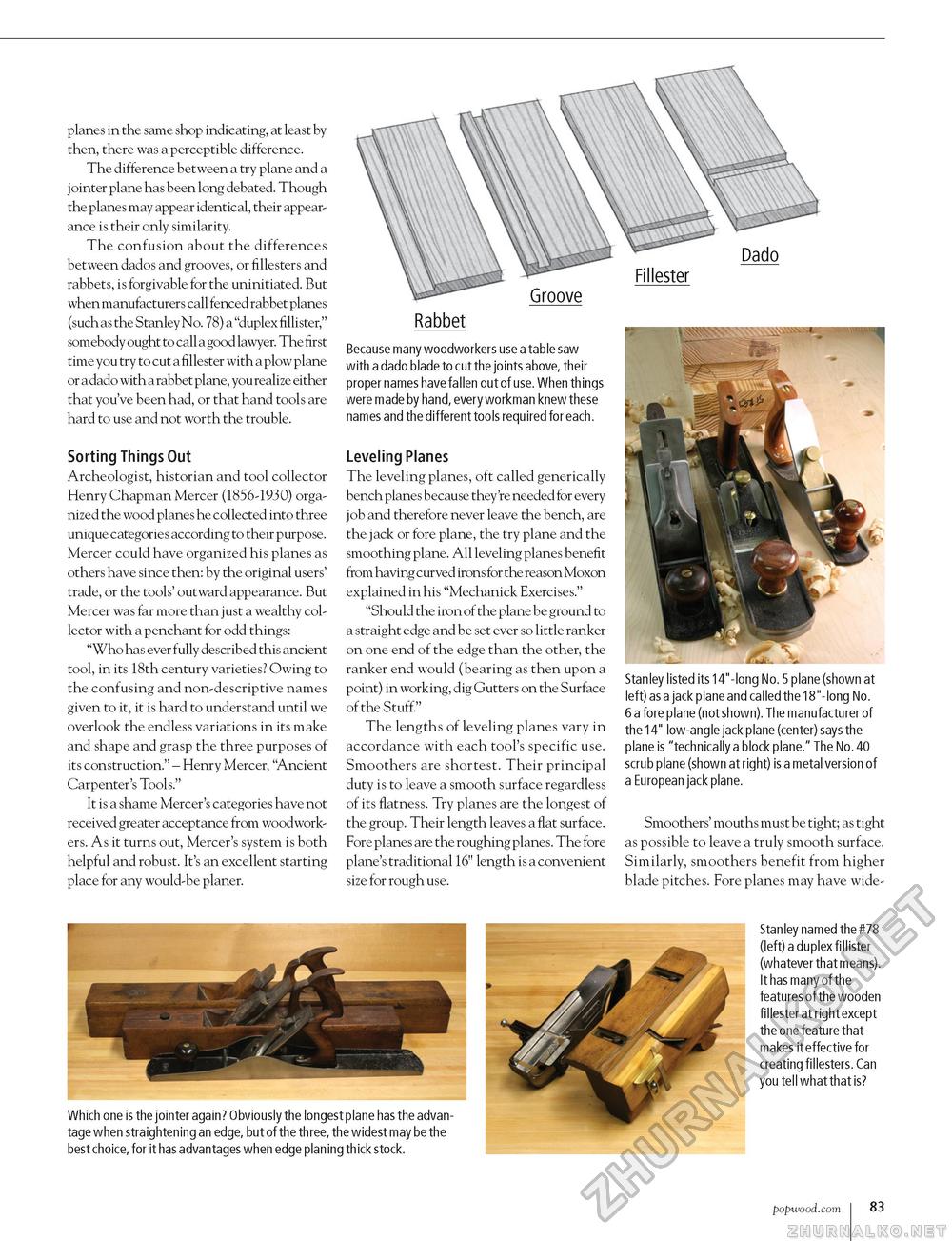Popular Woodworking 2005-08 № 149, страница 85
planes in the same shop indicating, at least by then, there was a perceptible difference. The difference between a try plane and a jointer plane has been long debated. Though the planes may appear identical, their appearance is their only similarity. The confusion about the differences between dados and grooves, or fillesters and rabbets, is forgivable for the uninitiated. But when manufacturers call fenced rabbet planes (such as the Stanley No. 78) a "duplex fillister," somebody ought to call a good lawyer. The first time you try to cut a fillester with a plow plane or a dado with a rabbet plane, you realize either that you've been had, or that hand tools are hard to use and not worth the trouble. Sorting Things Out Archeologist, historian and tool collector Henry Chapman Mercer (1856-1930) organized the wood planes he collected into three unique categories according to their purpose. Mercer could have organized his planes as others have since then: by the original users' trade, or the tools' outward appearance. But Mercer was far more than just a wealthy collector with a penchant for odd things: " Who has ever fully described this ancient tool, in its 18th century varieties? Owing to the confusing and non-descriptive names given to it, it is hard to understand until we overlook the endless variations in its make and shape and grasp the three purposes of its construction." - Henry Mercer, "Ancient Carpenter's Tools." It is a shame Mercer's categories have not received greater acceptance from woodworkers. As it turns out, Mercer's system is both helpful and robust. It's an excellent starting place for any would-be planer. Rabbet Because many woodworkers use a table saw with a dado blade to cut the joints above, their proper names have fallen out of use. When things were made by hand, every workman knew these names and the different tools required for each. Leveling Planes The leveling planes, oft called generically bench planes because they're needed for every job and therefore never leave the bench, are the jack or fore plane, the try plane and the smoothing plane. All leveling planes benefit from having curved irons for the reason Moxon explained in his "Mechanick Exercises." "Should the iron of the plane be ground to a straight edge and be set ever so little ranker on one end of the edge than the other, the ranker end would (bearing as then upon a point) in working, dig Gutters on the Surface of the Stuff." The lengths of leveling planes vary in accordance with each tool's specific use. Smoothers are shortest. Their principal duty is to leave a smooth surface regardless of its flatness. Try planes are the longest of the group. Their length leaves a flat surface. Fore planes are the roughing planes. The fore plane's traditional 16" length is a convenient size for rough use. Dado Fillester Stanley listed its 14"-long No. 5 plane (shown at left) as a jack plane and called the 18"-long No. 6 a fore plane (not shown). The manufacturer of the 14" low-angle jack plane (center) says the plane is "technically a block plane." The No. 40 scrub plane (shown at right) is a metal version of a European jack plane. Smoothers' mouths must be tight; as tight as possible to leave a truly smooth surface. Similarly, smoothers benefit from higher blade pitches. Fore planes may have wide- Which one is the jointer again? Obviously the longest plane has the advantage when straightening an edge, but of the three, the widest may be the best choice, for it has advantages when edge planing thick stock. Stanley named the #78 (left) a duplex fillister (whatever that means). It has many of the features of the wooden fillester at right except the one feature that makes it effective for creating fillesters. Can you tell what that is? popwood.com I 83 |








